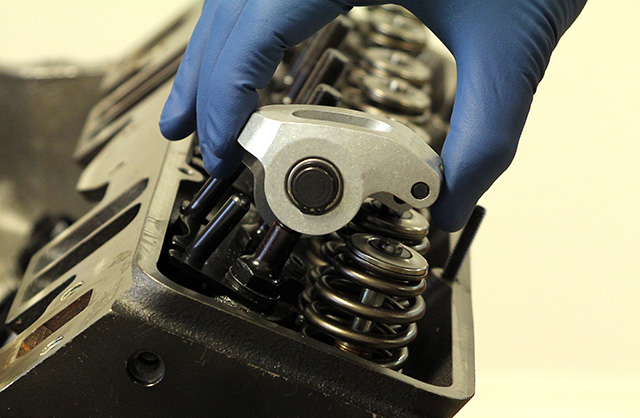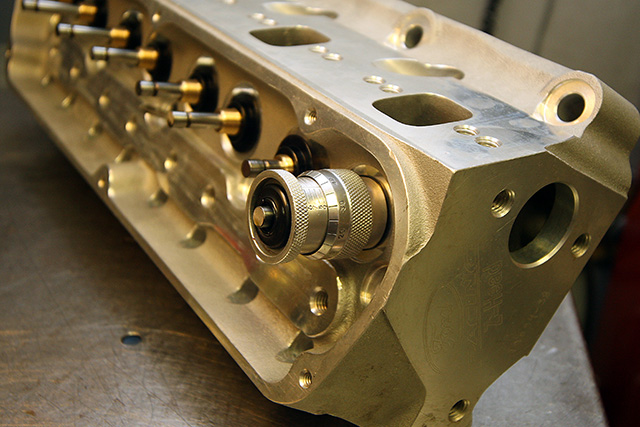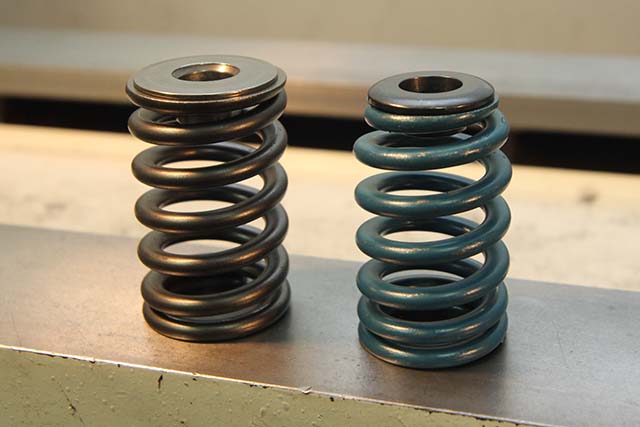OK, the unbreakable valvetrain is a myth, but here are top tips to make the most out of the valvetrain in your race engine.
The valvetrain in modern race engines see more stress than practically any other application. You’ve got engines running higher rpm levels than ever before. The engines in lower classes are still required by the rules to run fairly heavy valves and other valvetrain components. The length of feature races means the valve springs have to be able to endure long-term abuse. And the springs see wild swings in rpm several times every lap.
That’s why choosing the right springs, and dialing in the valvetrain in general, is so critical. Because of the wide variety of different cars and classes, there is no single best spring or valvetrain setup to cover every situation. Instead, you have to use your head and make the most of available resources to choose what will work best for you. But there are some baseline concepts that will help you as you build your next race engine–no matter what class you race.
Weighty Matters

This is a beehive spring below the Lunati aluminum rocker. Notice how the top coils are significantly smaller than the rest of the spring. This helps cut weight of both the spring and retainer.
It doesn’t matter what you are racing, shedding as much weight as possible while maintaining adequate strength in components to ensure durability is always a positive. It’s no secret that light makes right in racing, but how you get there can be a little tricky.
The reasoning is simple: The lighter the valvetrain, the easier it is for the valve spring to keep it under control. Newton’s second law is “Force equals mass times acceleration,” and for racing you might as well replace “acceleration” with “rpm.” So if a valve spring is only able to overcome a specific amount of force, then cutting mass means you can get more rpm out of it.
“The valve is a big player when it comes to weight in the valvetrain,” explains Allen Bechtloff of Crane Cams. “If you are allowed to run titanium and can afford it, then that is the way to go. But many classes require a steel valve. If you have to run stainless steel, then you might be able to get rid of some of that weight by running a skinny valve stem. Of course, the stem size in many lower classes is regulated by the rulebook too. Some will try to get around this by running a hollow stem steel valve, and we’re not necessarily recommending that if it’s illegal. But hey, you need to know they are out there.”
Of course, Bechtloff says that while the valve is the biggest contributor to weight in the valvetrain, there are other components that must be considered as well. Besides the valve, the most important components are the retainer, the locks, the top third of the valve spring (we will explain this in more detail later), and the rocker arm from the center of the pivot point to the end that contacts the valve stem. Everything on the other side of the rocker arm’s pivot point, which includes the pushrod and the lifter, are not nearly as weight sensitive.

Valve spring installed height is a critical consideration for any valvetrain. It influences the spring pressure both with the valve on the seat and fully open. A valve spring height mic is the easiest, most consistent way to accurately measure installed height.
Believe in the Beehive
“In many applications a beehive spring is an excellent choice,” explains Lunati’s David Chamberlain. “The beehive spring works by wrapping the coils progressively smaller near the top of the spring. The bottom coil of the spring is resting on the spring seat, and it doesn’t move. The first few coils above it also move very little, and each coil moves a little more as you get to the top. This distinction may not seem like a big deal, but remember this happens every time the spring is compressed to open the valve.
“So the coils that have the most effect on valvetrain mass are the ones at the top of the spring. A beehive takes advantage of this by making the upper coils smaller than the coil at the bottom of the spring. It also means you can use a much smaller, and lighter, retainer, which can also help to significantly cut overall valvetrain weight. Because of this, a well-made beehive valve spring can actually do the same job with a little lighter spring tension than a conventional straight spring.”
Retainers
If we follow the logic that the most important coils in a valve spring are the ones near the top (because they see the greatest movement), then it only makes sense that the retainer you use is also critically important.
Both Bechtloff and Chamberlain advocate using a beehive valve spring whenever appropriate, but caution that there are applications where a beehive simply won’t work. Namely, beehives can only work in a single-coil configuration, which limits their maximum spring tension. A double nested valve spring may be your only option if you need a lot of spring tension. Also, a nested valve spring gives you a bit of a security blanket in case you ever break a spring. With a nested spring you always have a second spring to help push the valve back up so, hopefully, you won’t break a valve. If, in the off chance a beehive valve spring breaks, there is nothing keeping the valve from contacting the piston.

To operate most efficiently, each valve must exert the same pressure on its valve. To do this the installed height on every valve must be equal. A good cylinder head specialist will mill the spring pockets in his cylinder heads so that they can be shimmed to get exactly the installed height the valvetrain requires.
“Keeping the retainer as small as possible will obviously help with weight, so that is definitely a strength of the beehive,” Chamberlain says. “Titanium is the lightest option when you are looking for valve spring retainers, but it is a softer metal than steel so it can gall up over time. This can especially happen where the retainer contacts the steel valve locks. Titanium has good shear strength, so it can hold up to a strong valve spring, but because it is softer it can gall up and cause problems.
“Tool steel retainers are a good option,” he continues. “In fact, they are probably my favorite option. The tool steel is very strong, so the retainer can be thinner than either a chromemoly steel or titanium piece, so if you have a smart design they can be nearly as light as a titanium retainer without the galling problem.”
Besides the tendency to gall in the areas where titanium mates against steel, Bechtloff also cautions that titanium retainers should not be used with a very specific type of spring. “If you have a double nested valve spring with a damper coil in between them, that damper coil is a flat wire wound vertically. That creates an edge that can chew into the titanium retainer and cause it to fail over time. Titanium retainers and valve springs that use a damper really aren’t compatible.”

Here’s a comparison shot between a conventional straight valve spring and its mating retainer (left) and a beehive spring (right). The difference in weight of the retainers is only a couple of grams, but at 7,000 rpm or more that really adds up.
Harmonics
Every valve spring has a natural frequency that its coils want to move in. When the engine hits the rpm that matches that natural frequency, it sets up a harmonic pattern that feeds upon itself and won’t go away until the engine moves beyond that rpm range. The rpm where this happens varies depending on several factors, including the spring’s wire size, the coil diameter and the camshaft’s lobe pattern.
The problem with a valve spring going into a harmonic state is it greatly reduces its effectiveness at maintaining valve control. On the dyno you will see a dip in power, and from the driver’s seat you may feel the engine running rough. Many times racers mistake a valve spring harmonic problem with a fuel or ignition issue. The loss of valve control can be so strong that it effectively acts as a rev limiter, and sometimes the engine simply cannot power through it.
“The severity of the harmonic condition increases with the rpm,” Bechtloff explains. “And most of the time in racing you are passing through one or two harmonic phases. Usually you blow right though the harmonic point so quickly you don’t even notice it, but the severity gets compounded by rpm. If you are at a tight track where you scrub off all your speed and you hit that harmonic point while you are trying to accelerate down the straight, it can really hurt you.”
Unfortunately, there really isn’t a sure-fire cure for a harmonic situation that’s killing engine power at the wrong point in your power band. You can change the cam profile or the spring, but either may cost you valuable power. Both Bechtloff and Chamberlain, however, did suggest working on your valve springs’ installed height can be a big help.
Installed Height and Coil Bind
A valve spring’s installed height is the distance between the bottom and the top of the valve spring when it is installed on the cylinder head. Usually, it is measured from the top of the spring seat to the bottom of the retainer with the valve closed (nothing pushing on the valve to hold it open).
There are three ways to adjust the valve’s installed height. First, you can swap the valve with one having either a longer or shorter stem. Second, you can use locks that reposition the retainer either higher or lower on the stem. And third, you can add or remove shims underneath the valve seat. Adjusting the valve’s installed height is most often done to influence the spring’s pressure on the valve, but it is also useful to bring the spring closer to coil bind when the valve is fully open–which can be helpful to reduce the harmful effect when the spring goes into a harmonic phase.

Pushrods also play an important role in how well your valve springs perform. Your pushrods may seem as solid as a rock, but at race speeds smaller pushrods can actually flex, creating a trampoline effect on the rocker arms when they straighten back out as soon as the lifter rolls over the nose of the cam. Whenever possible, run a 3/8-inch diameter pushrod (or even bigger) with a thick wall, instead of the smaller 5/16, to help increase stiffness. Fortunately, weight on the lifter side of the valvetrain isn’t as critical as it is on the valve side.
But before we can get into how that works, one more quick definition. Coil bind is when the valve spring is squeezed to the point that the coils are all stacked together and the spring cannot be compressed any more.
“We always say we want you to be 0.050 of an inch away from coil bind,” Bechtloff says. “So if you have a 0.550 lift cam, we want the spring to be able to travel 0.600 before coil bind. But if the spring is getting into its harmonic point and gets unhappy, you can bring it down to 0.040 or even 0.030 of an inch from coil bind. This seems to help calm the spring down so that the harmonic condition isn’t as harmful to maintaining valve control.”
“I can think of one instance with a circle track guy who had his engine on the dyno,” Chamberlain adds. “He kept running into a dip on the horsepower curve, which is pretty common with these engines. It turned out to be a harmonics issue with the frequency of the spring, so we told him to shim up the valve springs a little bit and bring them closer to coil bind. He had about 0.080 of an inch in them and brought them closer to 0.050, and that helped quite a bit.
“What it seems to do is when the spring doesn’t get close enough to coil bind and hits its harmonic state, it will go into a high-speed wobble, and it never gets a chance to straighten itself out. All that energy is used up and the spring can’t do its job. But by being closer to coil bind the spring just doesn’t have room for that wobble to get going.”
When Lighter is Better
“We did a very interesting endurance test with Keith Dorton of Automotive Specialists,” Bechtloff tells. “We actually ran two different valvetrain setups–one on each bank of the engine. On one side was a valvetrain all of his design with very light components. It used a lightweight valve that was titanium with a narrow stem. There was also a narrow, physically lightweight spring with a tiny button retainer. So the spring pressure was just 145 pounds.
“On the other side of the engine we did all old-school stuff. You know, a big heavy spring with lots of spring pressure. And we did an endurance test. We did over 3,000 simulated laps on a 1/2-mile short track.
“The interesting thing is we couldn’t even finish the test. We had to stop the test–I think twice–to replace the heavy stuff even though we had titanium retainers on the heavy side just to help it out a bit. But the lightweight stuff at the end of the 3,000 laps looked great. There was no deteoriation, it still had good spring tension, it was still as good as when it first was installed on the engine.
“It just goes to prove that a lightweight, happy valvetrain is the much better option.”
Sources
Crane Cams
cranecams.com
Lunati
lunatipower.com
















